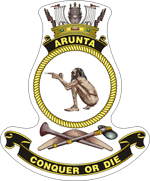
Back Arunta (Schiff) German اچامایاس آرونتا (آی۳۰) Persian HMAS Arunta Finnish HMAS Arunta (I30) French HMAS Arunta (I30) Italian アランタ (駆逐艦) Japanese HMAS Arunta (I30) Ukrainian HMAS Arunta (I30) Vietnamese
 HMAS Arunta during World War II
| |
| History | |
|---|---|
| Namesake | The Arrernte people |
| Builder | Cockatoo Docks and Engineering Company |
| Laid down | 15 November 1939 |
| Launched | 30 November/1 December 1940 |
| Commissioned | 30 March 1942 |
| Decommissioned | 21 December 1956 |
| Motto | "Conquer or Die" |
| Honours and awards |
|
| Fate | Sold for scrap in 1968, sank while under tow in 1969 |
| Badge |  |
| General characteristics | |
| Class and type | Tribal-class destroyer |
| Displacement |
|
| Length |
|
| Beam | 36 ft 4.75 in (11.0935 m) |
| Draught | 9 ft (2.7 m) |
| Propulsion | Parsons geared turbines, twin screws. 44,000 horsepower |
| Speed | 36.5 knots (67.6 km/h; 42.0 mph) |
| Complement |
|
| Sensors and processing systems |
|
| Armament |
|
| Notes | Taken from:[1] |
HMAS Arunta (I30/D5/D130) was a Tribal-class destroyer of the Royal Australian Navy (RAN). Named for the Arrernte Aboriginal peoples, the destroyer was laid down in 1939 and commissioned into the RAN in 1942.
Arunta fought during the second half of World War II; initially as a convoy escort and patrol ship, then in the shore bombardment and amphibious landing support roles while attached to the United States 7th Fleet. During the war, she was responsible for sinking Japanese submarine Ro-33 off Port Moresby on 24 August 1942, and earned five battle honours (one of which was later rescinded). After the war's end, Arunta underwent two deployments to Japan as part of the British Commonwealth Occupation Force.
The ship underwent a lengthy modernisation from 1949 to 1952, and was reclassified as an anti-submarine destroyer. After conversion, Arunta served in Korean waters after the Korean War armistice, and was one of the first Australian warships assigned to the Far East Strategic Reserve.
Arunta was paid off into operational reserve at the end of 1956, where she remained for twelve years. In 1968, the destroyer was sold for scrap, but was never broken up, instead sinking while under tow off Broken Bay on 13 February 1969.
© MMXXIII Rich X Search. We shall prevail. All rights reserved. Rich X Search